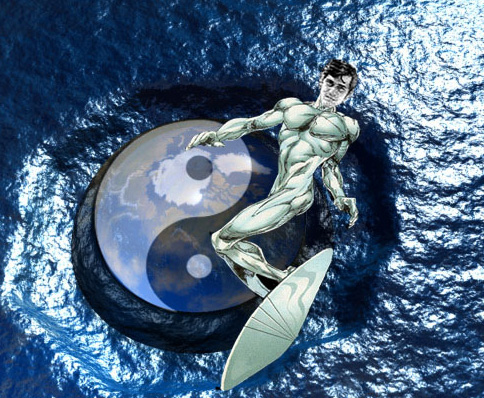Crazy idea, I know, but it was enough to get me off my ass and build another power unit that might be good enough to replace the one on my PVC CB.
In the center of this field generator is a ring of extremely dense orgonite with a 100' mobius coil. The inner ring consists of 6t black iron oxide and 1t powdered aluminum and just under a quart of resin. The medium density, and bulk of this unit, is aluminum chips, trace amounts of powdered metals, and brass shavings. Eight magnets were fixed to the outside of the mould to polarize the metals closest to the coil. The last and final layer consists of resin and powdered selenite.
On it's own, this unit will just passively transmute DOR (dangerous orgone) into POR (healthy, life-enhancing orgone) with barely enough energy output to stimulate the extra high density inner ring. Pumping frequency through the mobius coil is more than enough to kick start the extra high density ring and radically ramp up the power output. What these units need is something in the center to direct the energy.
Each time I build one of these units I end up spending considerable time and energy finding the proper size, shape, and density for a core that's compatible for the unit. A good core for one unit isn't necessarily good unit for another and I'm at a total loss as to why. One unit might require the same material as the inner core. Another unit might work better with a crystalline structure. Since this unit is meant to concentrate and direct the energy in one direction, I decided to quit messin around and build a new core for this device.
 There's three densities to the core you see to your left. The cone has a copper oxide/powdered aluminum ratio of 3:1 with a half gram of mono-atomic gold. The cylinder is medium density orgonite housing a three layer orgone accumulator made up of electrical tape and steel wool. The top of the cylinder, which would be the bottom when complete, has a hematite cap with two cat coils to direct the energy. The final layer is low density resin with slight traces of iron oxide.
There's three densities to the core you see to your left. The cone has a copper oxide/powdered aluminum ratio of 3:1 with a half gram of mono-atomic gold. The cylinder is medium density orgonite housing a three layer orgone accumulator made up of electrical tape and steel wool. The top of the cylinder, which would be the bottom when complete, has a hematite cap with two cat coils to direct the energy. The final layer is low density resin with slight traces of iron oxide.An open 1" copper pipe runs the length of the unit.
This design satisfies the requirements for a ramped up mini orgone accumulator. Metal on the inside, organic material on the outside with the pipe as the outlet. Multiple internal layers of metal and organic material should be enough to make this thing kick ass but putting it in a powered up unit will increase the energy output considerably. Since an orgone accumulator will attract all orgone, DOR as well as POR, this unit should attract and transmute energy better than any passive device.
I wasn't too impressed when I injected this unit with Solfeggio frequencies, the same frequencies that make Jupiter 2 produce that most excellent energy signature you can feel thirty feet away. When in doubt, try everything so I got the frequency generator from the PVC CB, installed new batteries, hooked it up, and hit the switch. It took about a minute before the 14Hz saturated the unit. It started out slow with an energy signature developing around the surface of the cone and about two minutes after that I could feel that distinctive tingle out the top of the pipe. No doubt about it. This thing is putting out some concentrated power, directed up the pipe and very little anywhere else. Dropping a Herkimer crystal down the pipe amped it all the more and the sensation was instantaneous.
I can't help but wonder why my small battery powered frequency generator outperformed the Solfeggio frequencies jacked up through a big ass amplifier. Why do some units react to one set of frequencies while other units resonate to completely different frequencies and not others? I know I'm missing something here and all I can do is keep working on it til I find it.
This project is far from complete. I need to round off the sharp edges, at the very least. Yeah... edges. I think I can write a book on orgonite edge theory alone.



No comments:
Post a Comment